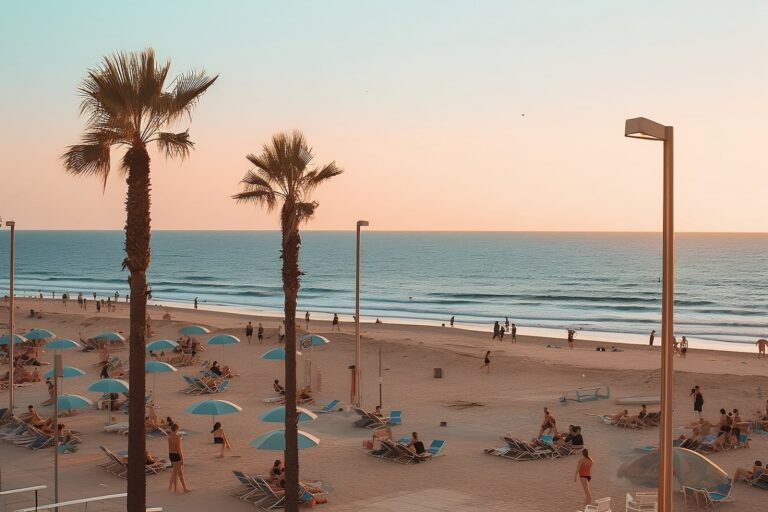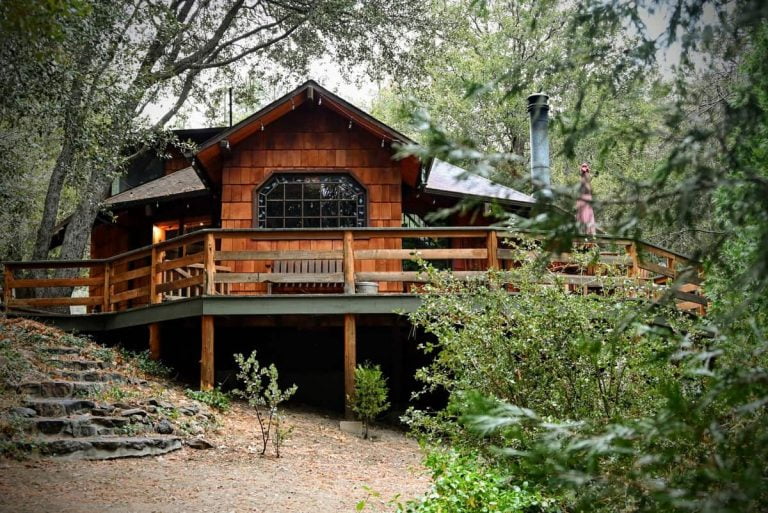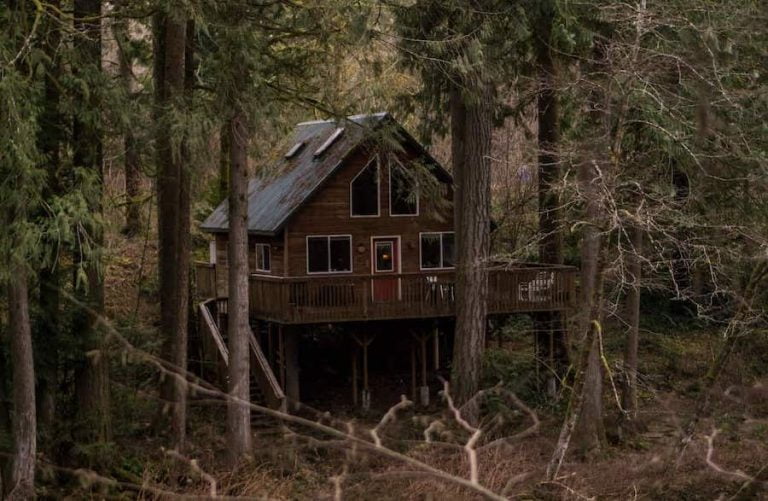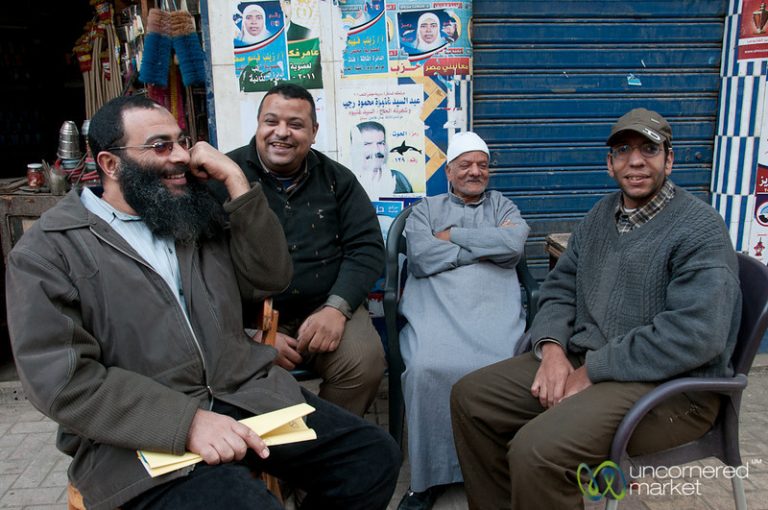Yerba Mate, Everywhere, All the Time — A Complete Guide
I tread a well-worn path — the path of the foreigner who, after a trip to Argentina, gets into the hot beverage called “yerba mate”, also known just as “mate” (pronounced matt-eh).
But I’m a bit different. I’m a diehard coffee lover, even though I’m from a tea-drinking cultural background. I travel everywhere with my AeroPress and hand-grinder coffee kit, plus other paraphernalia, and use a varying recipe with the most delicious beans for optimum brewing. I’m not like an industry pro, but I’m pretty into it for a consumer.
See here for my travel coffee kit, optimised for compactness and deliciousness!
To someone like me, the concept of sticking a ridiculous amount of leaves into a weird cup and brewing it in a specific but mostly unscientific way, following certain traditions lest the population of Argentina collectively wail in anguish, is entirely anathema.
I’m also, however, really into adopting little bits of local culture. The cuter they are, the better. And if they also have gastronomical — and perhaps health benefits — then all the better.
I’ll try to answer every frequent question I get about yerba mate below.
Note that mate belongs to places other than Argentina. But my experience is limited to Argentina, and more broadly the Argentina / Uruguay region. A lot of the elements I mention below are common, of course.
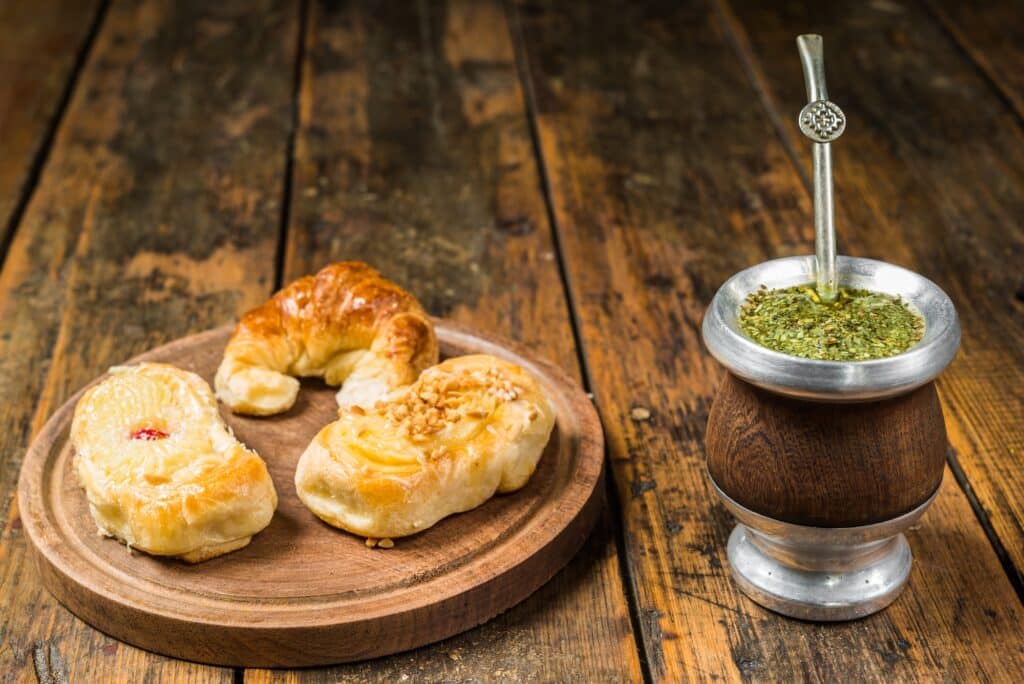
What Does Yerba Mate Taste Like?
“Why do you like it?” is the first question I’m asked. Like, coffee and tea are good enough for most people. Why do I need something new in my life?
Well, I don’t need something new. But I really like mate’s taste and how it makes me feel. And it’s fun to do something local, like drinking Arabic coffee when in the middle east.
My description of how mate tastes, in a nutshell, is: “It combines the bitter breakfastiness of coffee (or a strong tea) with the cleansing feeling of a light green tea, with a stimulating effect somewhere in between.”
My favourite description by an Argentinian about how mate tastes, from my friend (and coach) Francisco Vera: “Sabe a tierra… Pero nuestra tierra.” or “It tastes like soil… But our soil.” I think it was after that description that I started to “get” the appreciation for mate!
At some point I realised, unfortunately for my waistline, that mate pairs perfectly with Argentinian pastries (known as “facturas”, and most notably including the medialuna, a croissant-like pastry). The greasy light sweetness of the pastry and the bitter cut-through of the mate together is magical!

At another point later I realised they go well with alfajores (little sweet layered cookies / biscuits with dulce de leche sandwiched between them), and that you can also make different mate drinks by steeping it with other things, like milk and honey, a concoction I particularly enjoy.
I like the stronger mates, the ones that come “sin palo”, or without stems — see terminology below. But most people, including locals, opt for the smoother blends.
On caffeine content: Surprisingly, I haven’t found a clear description of the caffeine content of yerba mate, despite a lot of looking. Descriptions vary wildly and are spurious and unscientific. I can just tell you this: When I fill one small mate cup and steep it a number of times, it gives me a stimulating effect similar to a cup of freshly brewed coffee. Similarly, many people opt not to have yerba mate in the afternoons, but more people seem to have afternoon mates than afternoon coffees. Still anecdotal, but there you go!
Another thing I’ve noticed about the stimulating effect is that you can kind of tell when you’ve had enough mate. You feel a bit of a “buzz”, and know that more would be too much. So there’s a natural end to the party. If someone offers you mate at this point, you politely say “gracias” to decline. That’s when you’re done.
What is Yerba Mate? (Don’t Say It’s a “Tea”)
Yerba Mate, which most in Argentina just call “mate”, is a drink that is consumed in a way not dissimilar from tea or coffee (warm, as a stimulant, usually in the morning, often socially). But it’s made from a different plant, made entirely differently, drunk everywhere and all the time, and tastes different from both tea and coffee.
Aside from “what”, the “when” and “where” of mate together form one of the key differentiators. People drink mate everywhere, all the time. They drink mate in the morning, afternoon, and sometimes evening. They drink mate on buses, on planes, and on boats; at the office, at home, in parks, and at scenic natural spots; while walking, while driving, and while working out at the gym. The only time I haven’t personally seen someone drink mate is while on a bicycle or scooter, but I’m 100% sure it has been done.
Yerba mate is such a part of Argentinian culture (as well that of other mate-drinking countries, including at least Uruguay, Paraguay, parts of Brazil, and who knows where lese) that there is a mate emoji (🧉), and there are mate memes, and mate expressions.

“Wait,” you cry. “Is mate a drug?” No, it’s not. It’s not like cava or other traditional brews; there’s nothing hallucinogenic or psycho-active about mate. It’s not a drug. But it does really seem like one. Why is every Tom, Dick, and Facundo into it? Why are they drinking it everywhere, all the time? I don’t really know. It just has a certain “yo no sé qué” about it.
Some people call yerba mate a “tea”. It’s not tea; it’s not from the tea plant. I think the confusion comes from the fact that most people don’t realise “tea” is supposed to refer to drinks made from the specific plant, whereas the use of the word “tea” has been broadened out into general use (e.g. herbal “teas”) to mean “infusion”. It’s more accurate to say that yerba mate, like tea, or other drinks made from fruits and herbs, is an “infusion”.
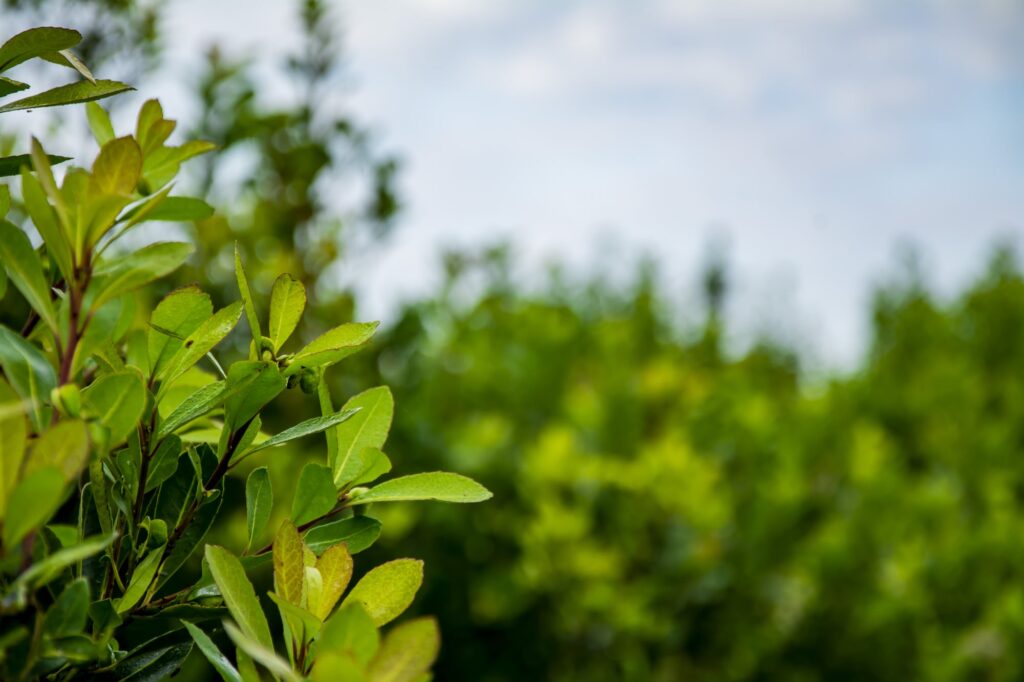
Yerba Mate comes from the plant Ilex paraguarienses, which grows in various regions of Latin America, and isn’t usually cultivated elsewhere (see more here in Wikipedia). Which doesn’t matter to the average consumer.
All we know is that we get the mate leaf in bags that look like these.
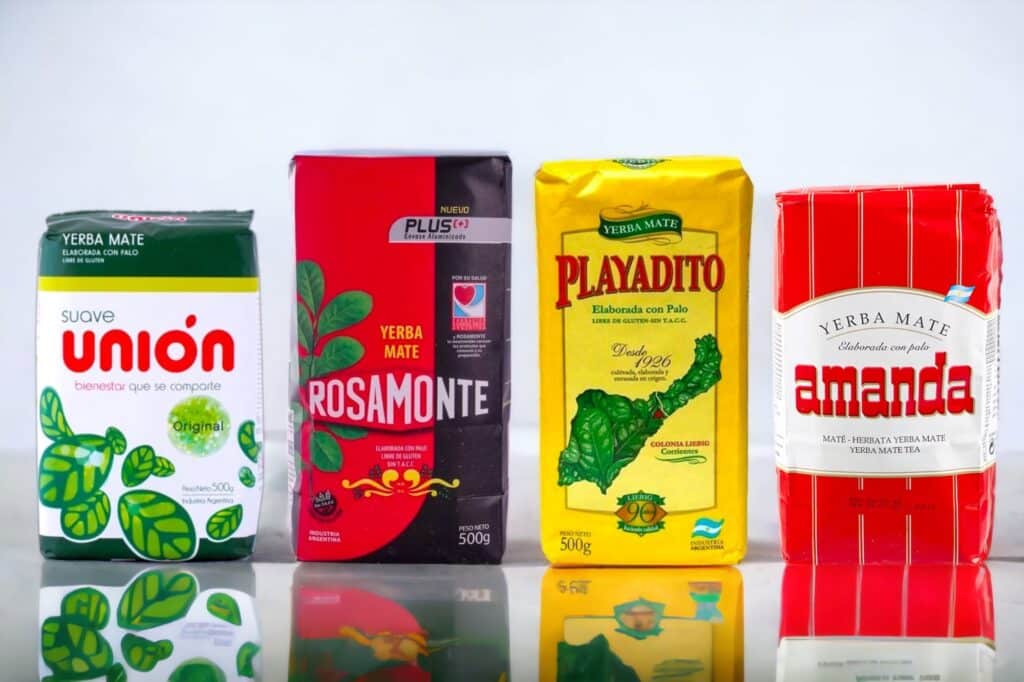
You can make yerba mate in any receptacle, but it’s most traditionally made in one made of calabash (calabaza), and drunk through a straw with a filter on the end of it, known as a bombilla (and that will be the last time I refer to it as a “straw”). More on terminology and brewing process below.
Mate Terminology
Before going too far, we need to lay some ground terminology. I don’t want to keep using the English words as it sounds weird to my ear, even though I’m not Argentinian or a native Spanish speaker.
Pronounce all these as you would in Argentinian / Rioplatense Spanish, most notably with the soft “z/c” (as “s”), and soft “ll” (as “zh”). (See here for a general guide to Argentinian Spanish differences).
- (El) Mate (“matt-eh”): Refers to the drink, or to the individual receptacle. Pronounced like “latte”. Don’t pronounce “mate” like an Australian* addressing their friend.
- (La) Yerba (“zherba”): The leaves. Sounds a bit like “herb” or the Spanish word “hierba”.
- (La) Bombilla (“bombizha”): The drinking tube with a filter on the end. Bombilla also means “bulb” in Spanish (e.g. a light bulb).
- El Cebador / La Cebadora: The “pourer”, the person preparing it for everyone. To cebar is to steep. The role of the cebador is a bit ceremonial.
- Palo: Means “stick”, but in mate it is used as con palo or sin palo. It means: Did they keep the stem of the leaf in, or just the leaf?
- Un termo: A thermos, not necessarily of the “Thermos” brand. Stanley, for some reason, is a coveted brand.
- Calabaza: The kind of gourd that a mate is traditionally made from. I’ve seen it written as “calabash” in English. People who think calabaza means “pumpkin” (e.g. European Spanish speakers): It’s not literally a pumpkin! But it is related; just a much smaller gourd. In Latin America, pumpkins are known by other words, like auyama in the north, or zapallo in the Rioplatense area.
- Alpaca: No, this has nothing to do with the animal. Also known as alpacca, or (misleadingly) as “nickel silver” or “alpaca silver”, alpaca is a popular material in Latin America for jewellery and adornment. It doesn’t contain silver, but it looks nice! It’s made of 60% copper, 20% nickel, and 20% zinc. It’s the most traditional adornment for a mate, but not necessarily the best in durability — it’s hard to compete with stainless steel.
* Yes, I know other English-speakers say “mate” to refer to a friend; basically most former British colonies other than North Americans. But allow me to inject a spot of parochialism.
What You Need to Make Mate
At a bare minimum, to make mate, you need a bombilla. This is a drinking tube with a filter on the end to avoid you sucking up leaves. That’s the minimum! (Without this, the leaves are pretty annoying.)
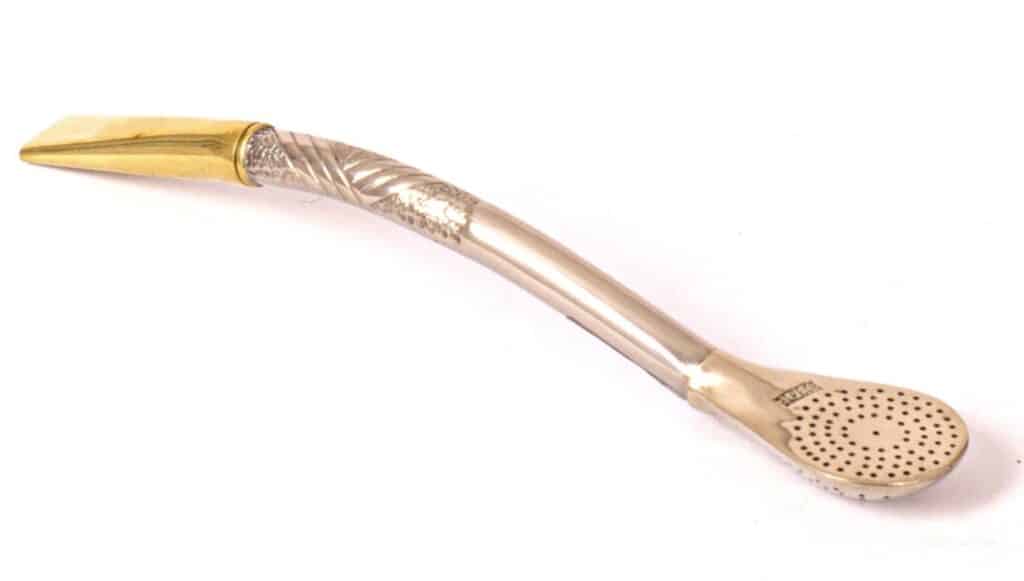
A minimal “kit” is a bombilla and a mate, plus some source of water of the correct temperature. This is most commonly a thermos (un termo). You can repurpose any steel water bottle, that generic kind of which I’ve been given several as branded marketing items in my life.
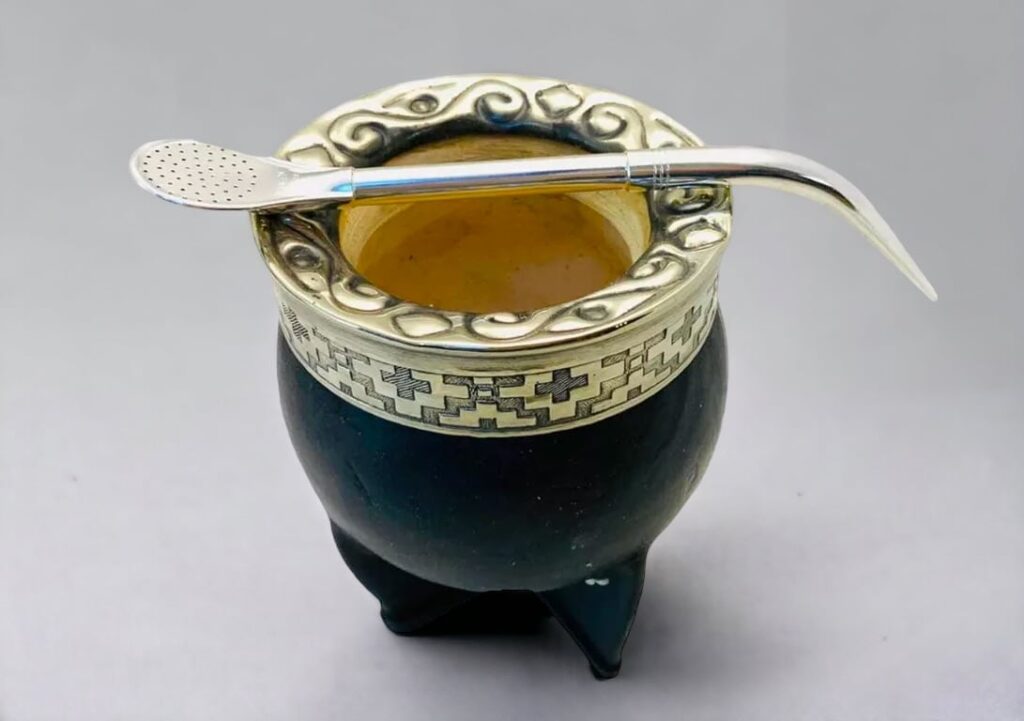
The maximum kit is those items, plus a dispenser for the leaves (so you don’t carry the packet around), and a carry bag for it all.
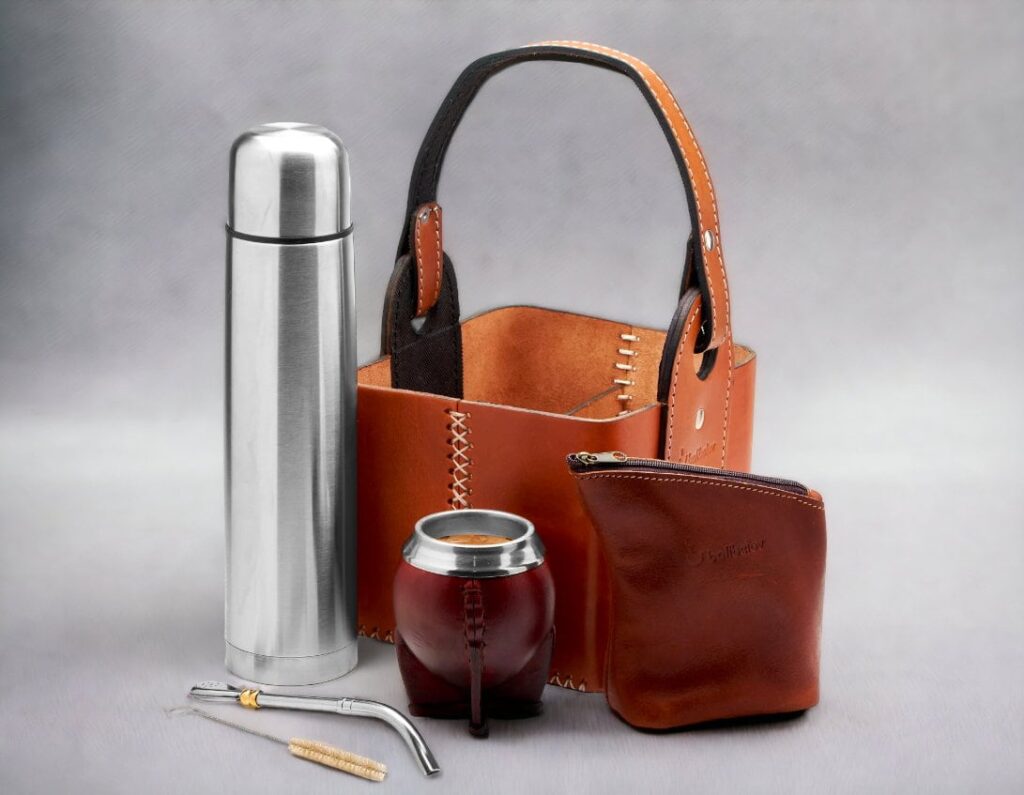
The max kit is something you’ll commonly see Argentinian people carrying around in picnic areas, on walks (or hikes), in airports or in bus terminals, and so on.
Once you learn what a mate kit looks like, you can spot a vacationing Argentinian from a mile away, and yell “Che, boludo!” to troll them into turning around. (Warning: If you do yell a friendly “Che, boludo!” at an Argentinian, be prepared to make room in your life for a new friend.)
What Kind of Mate to Buy — And Where
Note: I’ll put prices in USD, as with around 10% monthly inflation, the prices in Argentinian pesos will be almost immediately out of date. But do your own conversion to the cash rate at bluedollar.net.
Something that was hard for me to figure out was: What kind of mate should I buy? I wanted to originally buy the most traditional or old-school looking one, but then I eventually also got something more practical!
When you buy a mate, at a minimum I’d say you need the straw, which is known as a “bombilla”. In theory, you could use that and a small cup and you’d be set.
When buying a bombilla, I’d opt for stainless steel at first. It’s easier to clean and cheaper. Alpaca is the traditional kind, but it is more expensive (around US$10-20 just for this). I’d reserve that one for when you’ve developed a sense of what you want.
If you want to get the most traditional, iconic mate set: Get an “imperial” mate.

These are made of calabaza (gourd) and should be adorned with alpaca. The outer part is covered with leather, though of course in Buenos Aires you can also get “vegan” (i.e. faux leather) ones.
Aside from being the traditional material, people like calabaza because over time, it absorbs the flavour of mate, becoming seasoned, like a wok. I don’t really care; most of the flavour is definitely from the leaves.
When we shopped for imperial mates, we found the prices to be between $30-50 USD, depending on how ornate they are.
Very similar to the imperial style mates are the “camionero” style mates, also pictured above. They’re equally traditional, but often not as ornate, though a bit more suited for travel due to the tapered opening. (But any mate is fine for travel, really.)
When you get the bombilla with these, make sure it’s made of alpaca for maximum originality.
A second, extremely common form of mate, is the stainless steel one.
Stanley (yes, the hardware brand) first was popular for their thermoses, and now makes green steel mates that are the mate equivalent of the Apple iPhone.
Stanley mate goods are very popular and, for some inscrutable reason, status symbols of desire. Sure, they’re hardy and well-made, but they’re really over-priced for what they are, with the thermos (for example) costing around 5x what it would cost in the US — far more than just “taxes” or “exchange rates” would explain. Still, people seem to think they’re cool. Personally, I think gourd ones are much cooler, but maybe because I’m a foreigner and so have different associations with the brand.
If you really want a Stanley thermos, I’d suggest you buy it abroad, and for a couple of bucks by the “cebador” fitment to the end to make it convenient for mate usage.
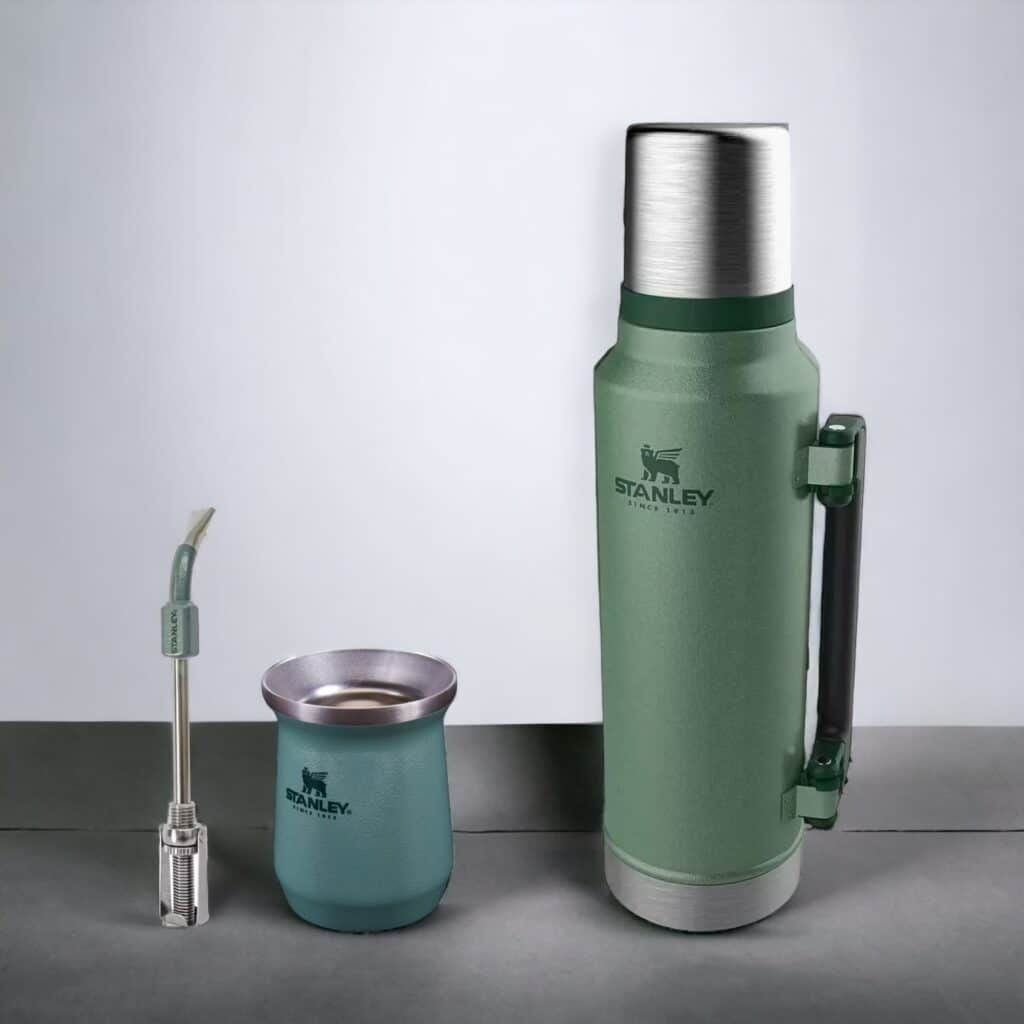
There are many simpler stainless steel mates you can buy. While they’re not the ones traditionally associated with gaucho farmers from the countryside, you can’t beat them for practicality: They’re easy to clean, hygienic as they don’t go mouldy, and unbreakable. Also, cheap, if you somehow lose them.
Finally, there are other materials you can get mates made out of. Wood is somewhere between gourd and metal in traditionality and practicality; it does get seasoned over time, but it’s not as easy to clean as steel.
I also have a ceramic one, because don’t like the scraping feeling of metal on metal (the bombilla on the steel cup), because I like to sometimes steep mate with hot milk, and because it looked nice.
When I return to Argentina, I’ll reward myself with the most traditional full kit seen on this planet. Get ready!
Where to Buy a Mate / Bombilla
There are five kinds of places you can buy a mate:
- From mate stores in CABA. Generally, these have a good selection of the basic kinds of mates, including a number of full kits. The prices are decent — they’re not rip-offs. The designs don’t get particularly edgy, but they’re good. If you’re in Argentina for a few days and you want one, just go to one of these stores. There are a few in the central areas. (Just look up “mate” on Google Maps.)
- From weekend street markets, where they have functionally OK ones but not the best ones. Usually, they’ll be made of calabaza, but not alpaca. The prices are actually reasonable — around US$5-10. Street markets tend to happen around places called “Plaza so-and-so”. Think of the quality/range here a bit like buying a simple wallet or a handbag from a street market.
- From online stores. Typically I find a mate through Mercado Libre (the local Amazon, which, as a non-resident, I can’t use), then contact the store directly or buy it through their web shop. This is a common way to use Mercado Libre (even for locals, to avoid fees!). You can usually pay with credit card this way.
- From hardware / everyday knick-knack stores. These are good places to get Stanley ones.
- From any local supermarket!
If you just want to dip your toe, go to your local supermarket (a “chino”) and buy a mate and a bombilla. They’re out the back near the take-away containers and so on. You’ll pay around US$1. A small investment to see if this is your thing.
The easiest place for most people to buy a mate would be from a store. But make sure you read this guide first, as they may only be able to give you limited assistance in what to buy. The staff in the stores I went to presented options but weren’t really able to explain which one to buy (and we were speaking Spanish). That decision is up to you.
In terms of size — Buy a small one. For 1-2 people, it should be roughly the size of a small table glass of water.
Types of Yerba to Buy and Where to Buy It
Here’s where things are easier. Any local supermarket (either a chain, or a Chinese-run one, known as a “chino”), will have an entire wall of mates.
Generally, there are three kinds of yerba:
- “Con palo” or “with stem”: By far the most common kind. It’s made with the leaf and stem of the plant. You just pick a brand and go with it.
- “Sin palo” or “without stem”: Much rarer, as it’s just the leaf, and it’s much stronger.
- Compuesto: With other add-ins, like orange rind, mint, lemon, various other herbs.
Most people drink yerba “con palo”. From there, it’s just brand preference — and they mostly taste the same, with just minor differences between them (not that noticeable to the non-drinker).
Common and easily-obtainable brands of yerba are:
- Union
- Rosamonte
- Playadito
- Amanda

You know, there are probably at least a dozen more commonly available ones, not to mention all the little brands. But I’ve tried these ones and they’re good!
Each of these brands of yerba typically goes for about $1-2 per 500 g bag, which should last a single person a couple of weeks. Families or offices buy the bigger bags.
If you want to try “sin palo”, your options are more limited. Most supermarkets only have a couple of brands in sin palo variety, and may not have any.
Every supermarket will have a few that are compuesto, though — with some add-in herbs.
The subject of compuesto vs not compuesto is somewhat hot and debated, with some people insisting that you never taint yerba with anything else. But lots of Argentinians do drink it this way, and are ultimately chill, and don’t care what you do.
I personally got into mate via a compuesto (with mint and some other herbs whose translations I never sought), then found myself appreciating it for its core elements. Compuesto was my gateway drug. (A bit like how I grew up having instant coffee with milk, and now brew it fresh and black.)
But it’s also very common for city-dwelling Argentinians to like mate compuesto. In health food stores, you can buy the separate herbs to make your own combinations! This is a bit reflective of the culture gap between CABA porteños, sometimes caricatured by people from the countryside as being obnoxious vegan hippies with an attitude problem, but that’s a story for another day.
How to Make Mate
OK, so you have all your equipment — at minimum, the mate receptacle, a bombilla, and a hot water source. Now you want to know how to make mate.
Here’s a dirty secret that may have my future visas denied: You don’t have to make mate in the traditional way to enjoy it. You could, in theory, make it in a French press, as one foreigner I know does. But if you did, a thousand million Latin Americans, including me as an honorable member, would throw their hands up in horror.
Besides, the mate ritual is quite enjoyable, and for me (and for some of my friends), is a central part of the experience.
In brief:
- Start boiling water to about 80C / 180F. You can also get it to boiling, then dilute it down with about 1/5 tap water.
- Fill the mate 2/3 full with yerba.
- Optional: Cover it with your hand, and shake it up and down. Wash the green powder off your hand. (I don’t do this, as I like the bitterness.)
- Tilt the cup to one side so the leaves are on a diagonal.
- With your hot water, gently pour some into the lower parts of it, so it becomes wet and keeps its diagonal.
- Put in the bombilla, lodging it into the leaves, leaving a hole beside the bombilla. That’s where you’ll pour steeping water.
- You’re ready!
Your bombilla should now be sitting in the hole on the side. Leave it there.
To serve mate, you steep it in bits at a time. You pour hot water into the hole near the bombilla, wait 30 seconds or so, then drink. The first pull is quite bitter, but it’s nothing as strong as tea would be.
Here’s a guide (in Spanish) from Taragüi, one of the bigger mate brands.
You can keep re-steeping for a while. I personally find mate loses taste after about 5-7 times, and becomes mostly like “vaguely flavoured hot water”. It’s not unpleasant, and some people do keep steeping for a while afterwards.
There are many questions that arise from this, especially to the scientific mind, like:
- So, do you just never steep the leaves at the top of the pile?
- How many times can one re-steep?
- What’s the correct yerba-to-water ratio?
- Why must I just have a slurp at a time? Why can’t I just brew a big cup of it and drink that?
- How do you keep water at the right temperature?
- Why can’t you drink it out of a mug? What happens if you do? Does the sun on the Argentinian flag consume me in its fiery embrace?
- Doesn’t calabaza get funky over time?
I’ve tried asking a few of those questions, and I either get bemused stares, or confusing answers. People don’t really know. It doesn’t matter. Think of it like someone asking you “What’s the correct weight of tea leaves or brewing time for a cup of tea?” Unless you’re a pro, you won’t have a good answer, and would feel like there are other factors at play; you just have the things you do and how you do them.
One definite thing about brewing mate is that to be a good “cebador” — to have mastered the art of making an aesthetically-pleasing and good-tasting mate — is something to be respected. It’s a little fiddly and takes time to figure out. It’s one of my long-term goals!
When and Where to Drink Mate
This is one of the craziest bits of mate, something I point out in my article on unexpected things I found out about living in Buenos Aires.
I grew up in a tea-drinking culture. I associate tea with older people or old souls. I especially associate a tendency to carry around a specific tea kit (to make tea in the way they like it) with my parents, who are as old as my parents. I’m sure many can relate.
The thing that’s different about mate is that everyone drinks it, all the time. It’s not just a morning drink enjoyed at home or at work by any specific cultural group. People drink mate regardless of age, gender, wealth bracket, social status, or region of origin.
People also drink mate everywhere. At some point, I realised that on Argentinian planes, you’re allowed to take entire bottles or flasks of water. I am not sure where this is because Argentinians are a bit more chill about security, or whether it’s because without this flexibility, nobody would be able to make mate on a plane!

I’ve seen people precariously preparing mates while on moving transport (like an inter-city bus), and drink mate while driving.
My personal two favourite contexts for a mate are a) in the morning, as a warm pick-me-up ritual, and b) outside in a natural environment at a time to relax, like when on a scenic walk or hike. But really, you drink mate whenever you feel like it.
Mate hasn’t got a discernible aroma. So it’s never something that bothers other people when you’re consuming it, making it suitable for close spaces like offices.
Mate Rituals and Norms (and Shibboleths)
There are a number of social norms regarding mate. I’ll try to loosely organise these from “Important” to “casual”.
If you’re on your own at home, of course, nobody cares. Argentinians are very chill people, flexible and accepting of a bit of chaos in life. But, a bit like Italians (with whom city Argentinians share a lot of traits), when it comes to food, this is where they get prescriptive and persnickety.
- Respect the tradition and methodology. Use some kind of standard mate, whether it’s stainless steel or some other material, but don’t make it in “any old thing”. When making mate, follow the standard process of having it up the side of the cup with the bombilla down one side, with a hole.
- Do not touch the bombilla to jiggle or move it around. Do not! It’s very upsetting to see someone do this.
- Wait your turn if you’re in a group. The round will go clockwise or counterclockwise depending on the cebador’s preferences. Don’t try to skip the line.
- Don’t slurp more than once. Once you’ve reached the bottom, it’s time for the cebador to add more water.
- The cebador should typically take the first sip — the bitterest one. (It’s also the one I like most, but that’s an unusual preference.)
- The cebador should always be the one pouring water. This is where things get more flexible — I’ve seen one person offer to do it, and the cebador never is upset or anything.
- Don’t blow back into the bombilla to clear out blockages.
Personally, I rarely share mate. It’s my morning drink and I’m often on my own then. If my partner is around, I share it with her, but we like slightly different styles!
But sharing a mate is extremely common. It’s an expression of friendship, about on the same level as saying “how are you”. (I think I’ve been offered mate roughly as often as I’ve been offered a drag of a joint!)
There are also a few shibboleths around mate making which I think are worth pointing out.
Some people say you should never initially steep with cold water. But then, lots of people do it. It makes for a smoother brew.
Some say you should never add cold water to hot water to cool it down to mate temperature, as it changes the taste. Having an education that forced me to do a ton of physics, I absolutely know there’s no difference chemically between hot water and cold water, so I call baloney on all of it.
Still, do what you feel like.
Wrap up
I never suggest rituals for the sake of rituals. But mate is ubiquitous, low-risk, and an easy way to connect with people in places that drink it.
For anyone staying in Argentina, I suggest that at minimum, you try it at home a few times. Get used to it. Then, when someone offers it to you, you can accept it with glee.
And if you’re like me, you’ll fall hard, and buy as much mate as you can fit into your luggage before leaving. You can buy it overseas, but it’s much harder to get, not often seen, and about five times the price, so it loses some of its appeal.
So for me, mate is one of those things I’ll think about and miss about Argentina — until I’m next there. One day, someone will praise me for my skills as a “cebador”, and I might just faint from joy.

